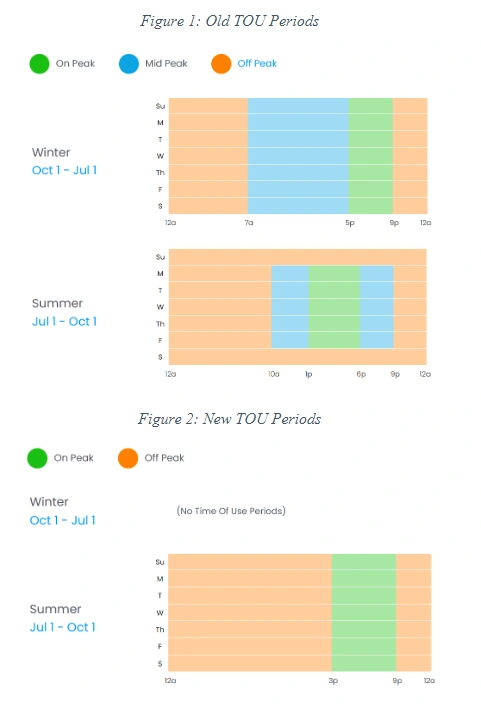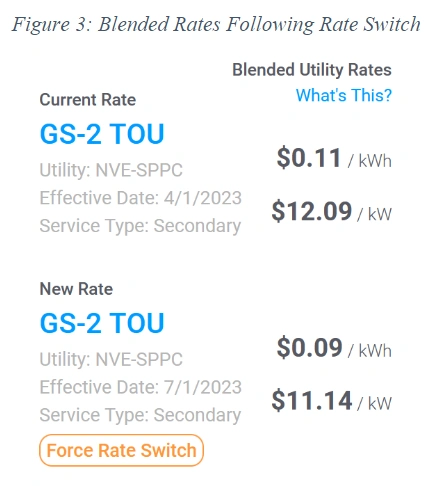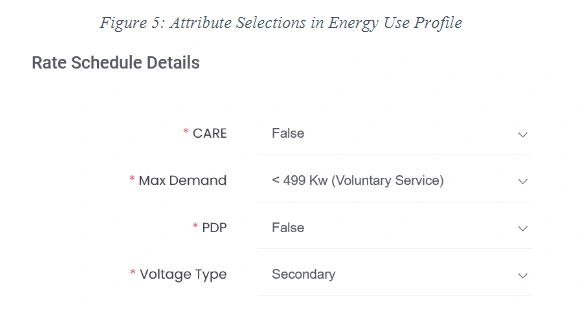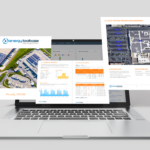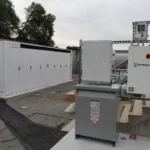IMPORTANT MONTHLY UPDATES & ANNOUNCEMENTS
This month, we explain NV Energy’s new time-of-use (TOU) periods, cover updates in Pacific Gas & Electric’s (PG&E) most recent advice letter, highlight an assortment of rate updates and new utilities, and explain the role of attributes when selecting a rate in ETB.
NV Energy’s TOU Restructuring
NV Energy Sierra Pacific Power (also known as NV Energy Northern) restructured its TOU periods in a recent update. The old TOU structure consisted of three periods—on-peak, mid-peak, and off-peak—for both the winter and summer seasons. The new TOU structure eliminates the winter TOU periods and removes mid-peak hours in Summer. An additional hour (six total) has been added to the on-peak period, which will now be present every day of the week rather than Monday through Friday.
Our rates team conducted a rate switch in a proposal using a small office load profile to compare rate GS-2-TOU’s old TOU periods to its new TOU periods. It was found that the TOU restructuring resulted in a blended rate decrease of $0.02/kWh and $0.95/kW:
We highly recommend using interval data to upload a customer’s usage into the Energy Use Profile instead of inputting usage from bills. The TOU restructuring complicates manually inputting energy usage from old bills into the new TOU periods because you must arbitrarily determine how to distribute the mid-peak energy usage into the new on-peak and off-peak hours. ETB Developer knows how to utilize the interval data to properly distribute the mid-peak usage, making the process much easier.
PG&E Revenue Requirement Increase and E-ELEC Revision
PG&E submitted an advice letter (AL-6968-E) effective July 1 to increase electric rates to collect $1.2 billion in revenue for wildfire and system reliability purposes. According to the advice letter, the total revenue requirement increased by 7.5%; this includes a 5.3% increase (1.6 cents per kilowatt-hour) to the system average bundled rates and a 10.4% increase (1.5 cents per kilowatt-hour) to the average rate for Direct Access and Community Choice Aggregation customers. These increases will remain in effect for a 12-month period concluding in July 2024.
The bulk of the $1.2 billion will be recovered through increases in distribution charges. For example, the distribution charges for rate B-1 increased by 15% from $0.1220/kWh to $0.1403/kWh. The remaining revenue requirements will be recovered through the Public Purpose Programs (PPP) surcharge, which has consistently been the costliest adjustment for PG&E customers as it has steadily increased over the years. From January 1, 2020, to July 1, 2023, the PPP for rate E-1 increased by 108% ($0.0124/kWh to $0.02578/kWh), and it will continue to do so as the costs to fund specific social programs like low-income assistance and energy efficiency increase.
Along with the rate updates, PG&E also updated the applicability section of rate E-ELEC to allow legacy NEM and NEM-2 customers to switch to rate E-ELEC, which is the default electrification rate for NEM-3 customers. Previously, NEM and NEM-2 customers were transitioned to E-ELEC at the end of their grandfathering period, but now such customers can voluntarily switch to E-ELEC. ETB users can utilize the rate switch option in the proposal to determine if it is advantageous to make the switch to rate E-ELEC for their NEM or NEM-2 customers.
Utility Roundup:
Rate Updates
- Alabama Power updated rate adjustment factors resulting in a 6.8% average rate increase.
- Delmarva – Delaware customers can expect bill increases of 8.35% as Delmarva seeks to recover an additional $72.3 million in revenue through distribution charges.
- Florida Power and Light is decreasing rates for a second update in a row by an additional 6% for residential customers and 3-5% for business customers.
New Utilities
- City of Mbombela (South Africa)
- Energuate (Guatemala)
- Peru Utilities (Indiana)
- Port of Stockton (California)
- Twin County Electric Power Association (Mississippi)
July FAQ: What are attributes?
Attributes are an ETB Developer function that allows us to accommodate different billing scenarios for the same rate schedule. For example, some rate schedules have different customer charges for different voltages—secondary, primary, or transmission voltages. We can use attributes in ETB to specify which voltage classification the rate is built for:
Attributes are also used for rates subject to certain programs like CARE or PDP, as well as rates with charges that vary with location (i.e., inside versus outside city limits). When you select a rate in the Energy Use Profile, you can also choose which attributes you wish to use for your rate:
Certain attributes that are the predominant options for most customers are selected as the default choices in the Energy Use Profile. It is important to double-check your bills to ensure that you use the correct attributes, as it can make a big difference in bill totals. If the attribute you need is unavailable for a rate, or if you are unsure which attribute selections to make, then contact our rates team atutilityraterequest@energytoolbase.com, and we’d be happy to help!

